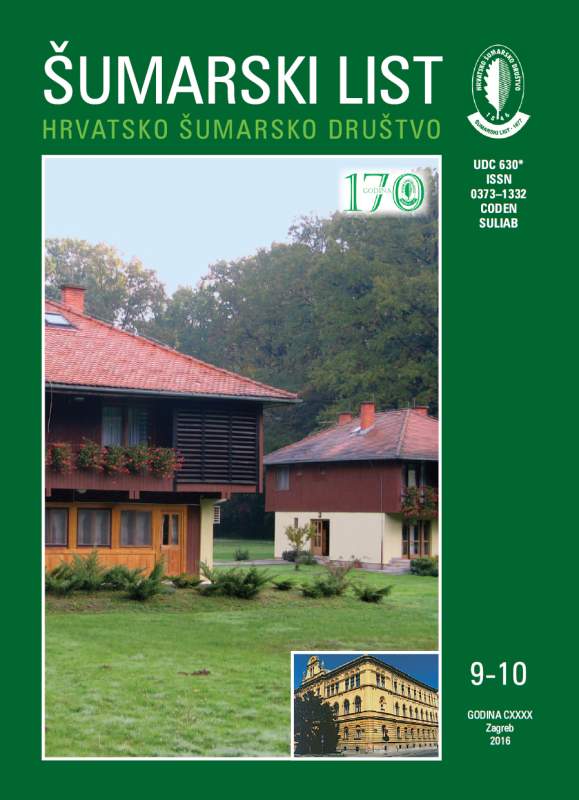
broj: 9-10/2016
pdf (9,69 MB) |
|
||||||||||||||
| RIJEČ UREDNIŠTVA | ||
| Uredništvo | ||
| EVALUATION OF FORESTS IN THE LIMATE POLICY AND THE CASCADE USE OF FORESTS pdf HR EN | 433 | |
| IZVORNI ZNANSTVENI ČLANCI | ||
| Tibor PENTEK, Andreja ĐUKA, Ivica PAPA, Darija DAMIĆ, Tomislav PORŠINSKY | UDK 630* 383 (001) | |
| THE EFFECTIVENESS STUDY OF PRIMARY FOREST ROAD TRAFFIC INFRASTRUCTURE – AN ALTERNATIVE TO STUDY OF PRIMARY FOREST OPENING OR JUST A SHORT-TERM SOLUTION? pdf HR EN | 435 | |
| Linda BJEDOV, Petra SVOBODA, Ante TADIN, Josipa HABUŠ, Zrinka ŠTRITOF, Nikolina LABAŠ, Marko VUCELJA, Alemka MARKOTIĆ, Nenad TURK, Josip MARGALETIĆ | UDK 630* 451+ 232.3 (001) | |
| INFLUENCE OF BEECH MAST ON SMALL RODENT POPULATIONS AND HANTAVIRUS PREVALENCE IN NACIONAL PARK „PLITVICE LAKES“ AND NATURE PARK „MEDVEDNICA“ pdf HR EN | 455 | |
| Summary The European beech (Fagus sylvatica L.) is at present considered to be the most common economically important and widespread tree species in Europe. In contrast to other tree species and economically important species in Croatia European beech has the largest areal and can be found in variety of plant communities. As the most specious and widely distributed mammalian group, rodents are the wildlife reservoir for many zoonoses which can infect humans and other wildlife. Rodent outbreaks tend to follow years with increased seed production of oak and beech. Many authors have linked fluctuations in abundance of rodent reservoirs with increase of human zoonotic infections. Aim of this research is monitoring of rodent populations and hantaviruses in beech forests. At two locations (National park Plitvice lakes and Nature park Medvednica) seven trapping plots were set, each containing 1 or 2 grids size 100m x 100m (100 traps). Rodent capturing was done from year 2011 until 2014 in summer and autumn. Beech mast was recorded in NP Plitvice lakes each year in autumn. Trapped rodents were screened for hantaviruses. Results show two dominant rodent species, yellow-necked mouse (Apodemus flavicollis) and bank vole (Myodes glareolus) in beech forests of NP Plitvice and NP Medvednica. Both species make 99 % of total captures. Rodent abundance showed increase in year 2012 and outbreak in year 2014 measuring on one grid max abundance of 45 animals/ha, whereas year 2011 and 2013 had lowest abundance. In beech forests of National Park Plitvice lakes and Nature Park Medvednica 3 different hantaviruses were found within their typical rodent host species: Puumala (PUUV) in bank voles (Myodes glareolus), hantavirus Dobrava (DOBV) in yellow-necked mouse (Apodemus flavicollis) and Seewis (SWSV) in common shrew (Sorex araneus) which makes first molecular evidence of shrew-borne Seewis virus in Croatia. Highest infection rate was found in bank voles with 50 % of Puumala positive individuals. Dobrava was found in 5 % of trapped yellow-necked mouse. In 2011 there was slight increase in beech seed production reported in comparison to year 2012 and 2014. In year 2013 beech seed production was the highest with mean beech seeds/m2 23x higher than in year 2012. From the rodent abundance and beech mast data we see the trend of mast years being followed with high rodent abundance. Highest proportion of hantavirus positive rodents was found in year 2014 when their abundance was also reported highest. From this data the connection of beech mast year and rodent abundance following next year as well as high infection rates of rodents is confirmed. In same years with increased rodent abundance there was high number of human HFRS cases (hemorrhagic fever with renal failure syndrome). Key words: small mammals; European beech; beech mast; hantaviruses | ||
| Krunoslav SEVER, Matija HRUST, Željko ŠKVORC, Saša BOGDAN, Ivan SELETKOVIĆ, Nenad POTOČIĆ, Jozo FRANJIĆ | UDK 630* 160 (Quercus robur L.) (001) | |
| ESTIMATION OF NITROGEN NUTRITION OF PEDUNCULATE OAK (Quercus robur L.) USING A PORTABLE CHLOROPHYLL METER CCM-200 pdf HR EN | 465 | |
| Luka KASUMOVIĆ, Boris HRAŠOVEC, Anamarija JAZBEC | UDK 630* 453 (001) | |
| EFFICIENCY OF DRY AND WET FLIGHT BARRIER THEYSOHN® PHEROMONE TRAPS IN CATCHING THE SPRUCE BARK BEETLES Ips typographus. L. and Pityogenes chalcographus L. pdf HR EN | 477 | |
| PRETHODNO PRIOPĆENJE | ||
| Tolga OZTURK | UDK 630* 375 + 114.7 | |
| THE EFFECTS ON SOIL COMPACTION OF TIMBER SKIDDING BY TRACTOR ON SKID ROAD IN PLANTATION FOREST IN NORTHERN TURKEY pdf HR EN | 485 | |
| Nevenka GALEČIĆ, Jelena TOMIĆEVIĆ-DUBLJEVIĆ, Mirjana OCOKOLJIĆ, Dragan VUJIČIĆ, Dejan SKOČAJIĆ | UDK 630* 582 | |
| QUALITY AND UTILIZATION POTENTIAL OF URBAN PARKS: CASE STUDY TAŠMAJDAN PARK, BELGRADE, SERBIA pdf HR EN | 493 | |
| PREGLEDNI ČLANCI | ||
| Hac Ahmet YOLASIGˇMAZ, Snan GÜNER | UDK 630* 231 + 232 | |
| THE PROCESS OF SILVICULTURE PLANNING IN TURKEY: HSAR CASE STUDY pdf HR EN | 503 | |


